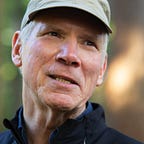Day 20 — On Pedaling versus Paddling
July 2, 2021. I decided to stay a second night in Craig, in part because it being a fly fishing mecca, it’s an interesting place to watch people who are 110% devoted to their sport. This got me thinking about the two sports I’m participating in on this trip, biking and canoeing.
Remember the old cartoons where the devil on the left shoulder is arguing with the angel on the right shoulder? I don’t hear those voices, but I do hear other voices on this trip. My left shoulder and my right elbow are constantly arguing with my left knee and my right Achilles Tendon. The shoulder and elbow say biking is by far the superior activity. While it’s true they don’t work as hard, they are correct in pointing out that we put in many more miles to get where we want to go. The bicycle is a marvelous technology for converting human power into motion. Why wouldn’t we take advantage of that.
Conversely the knee and the Achilles Tendon say canoeing is the by far superior. Yes, it’s far easier for them, but they point out that we flow along much more efficiently using the power of the river to bring us to our destination. Why use human power when you can use the power of the river? It’s also much more enjoyable, they say, since we get to enjoy the landscape as it flows by.
My bum and lower back are more ambivalent. My bum finds the canoe seat slightly less uncomfortable than the bike seat, and my back finds the bike slightly less painful than the canoe. So they are just constant whiners.
This argument is analogous to the larger question of the pros and cons of each sport. I find myself debating whether it is preferable to be on the bike, or in the canoe.
I can cover significantly more miles on a bike than a canoe, even with the assist of the river flowing at about 3 miles an hour. If I work hard, I can maybe turn that into 5 or 6 miles per hour, less than half the speed I can make on the bike towing the canoe on flats. The bike also engages many more faculties; the positioning of the foot on the pedals and the orientation of the knees, the shifting of the gears to match the topography, switching between sitting and standing, thinking about how the trailer and boat are tracking, the automobile traffic, surface conditions, avoiding obstructions like rocks and garbage, swapping up hand positions to reduce numbness in the hands, and a million other things constantly bombarding the senses.
In paddling, those sensations are significantly reduced, limited to the circular connection between the moving water, the paddle, the hands and arms, the torso, the seat, the canoe and the moving water. Attention is singularly focused on micro and macro adjustments of the canoe via the paddle in response to the verities of the river. It becomes rote after a while, allowing for other sensations to kick in: to pay more attention to the surrounding landscape as it flows by, to cogitate on other matters as they flow through the brain.
Perception of time and motion also take on different characters. On the river I find that the miles speed by, even though I am moving much slower. On a bike, it feels like every mile is earned, and thus takes forever to click by.
Combining the two sports into a pedal-paddle cross-country adventure involves hundreds of compromises, compromises that would frustrate both bike and canoe purests. Towing a canoe behind a bike on a trailer requires a beefier bike and fatter tires. My canoe and trailer setup along with my gear weigh about 110 pounds, significantly more than you would carry if you were just bikepacking. This means that the speed is reduced significantly and the amount of exertion, especially on hills, is increased. I find I also have to pay constant attention to the canoe and trailer, especially when turning and negotiation obstacles.
Conversely in the canoe, packing a bike and a trailer is a challenge. Neither fit well into the canoe. the load tends to be a bit top heavy, and the extra weight in the canoe probably slows the speed a few clicks. That said, with the bike and trailer stowed in the rear, I find that miles and hours go by without my even thinking about that bike
The transitions back and forth between canoeing and paddling also take a bit of time and work. Reassembling the trailer, loading the canoe and balancing the weight, disassembling the bike and putting it in and out of the canoe. All of these take time, so you don’t want to do them too often.
In the end, I come down on the side of my bum and my lower back, finding that the two activities complement each other very well. I might whine about one or the other, but overall I can’t think of anything else I’d rather be doing.
